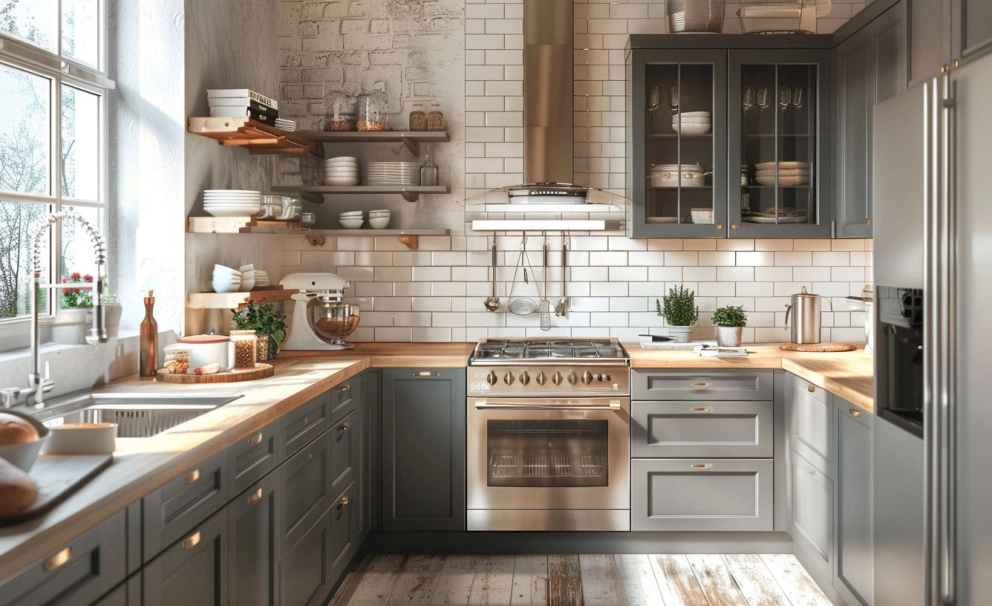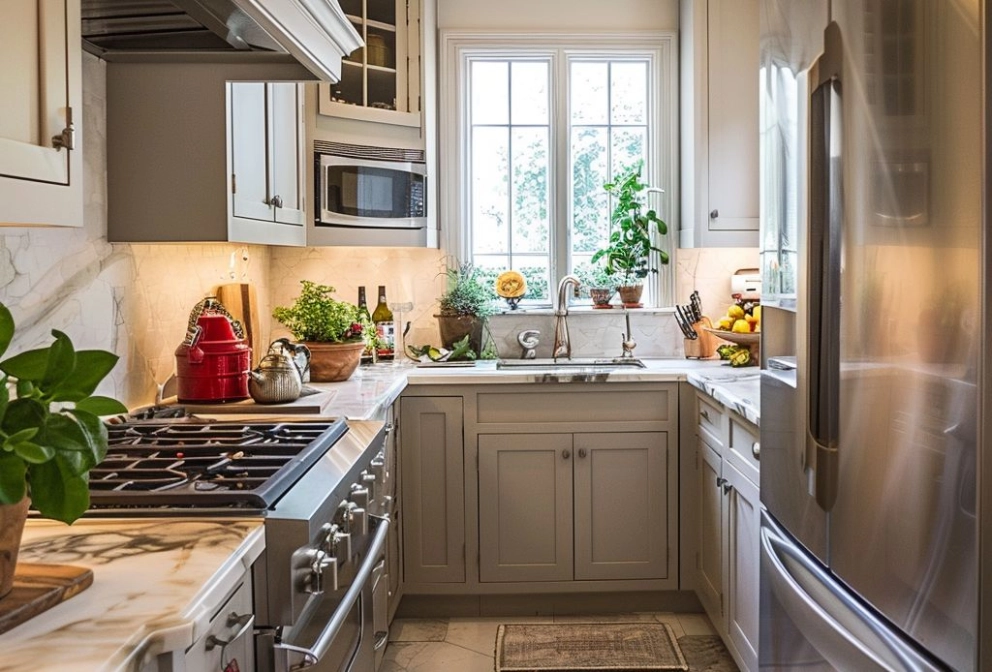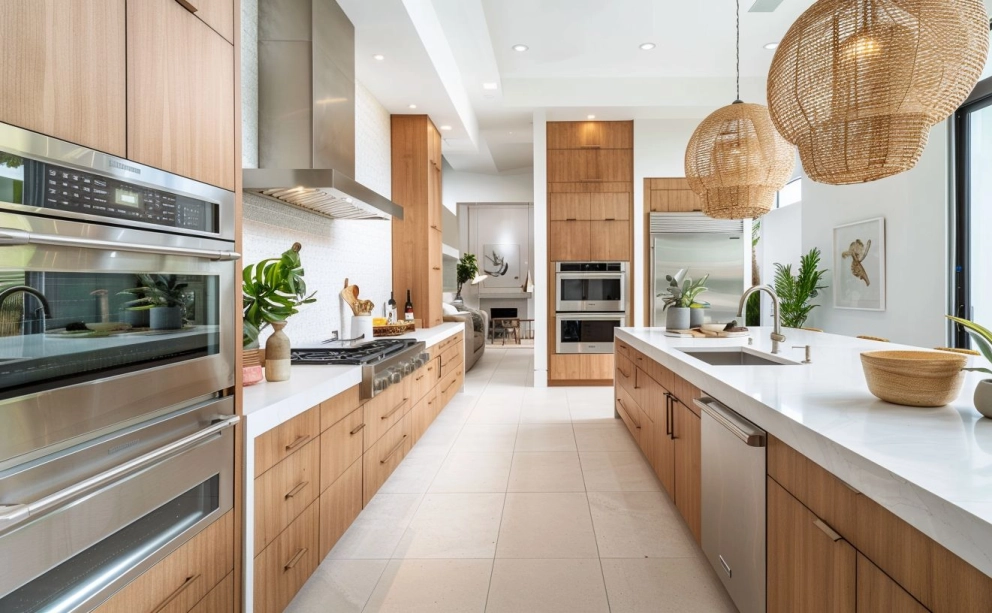Kitchen Textures - What to Choose and What to Skip
It's easy to become swept away in selecting a kitchen style, paint colour and appliances when planning a kitchen remodel or renovation. Kitchen texture is often overlooked in the midst of all the other visual choices. The truth is that texture is a key design element that affects more than just the way surfaces look and feel. It also influences how they catch light, reflect colours, and complement each other.

What is texture?
Think about the contrast of a sleek quartz countertop and reclaimed-wood shelves or a glass wall backsplash with hand-troweled walls. These variations can give a space a sense of depth and personality in a way that colour alone never could.
Texture is important for all parts of a kitchen and not just about one particular surface - cabinets, countertops, backsplashes, light reflection, and hardware shine. Each of the texture types offers something different to create richness, depth, and character in your kitchen:
-
Smooth and polished surfaces (quartz countertops, porcelain sinks, and glass tiles) are modern, clean, and easy to maintain.
-
Rough surfaces (exposed bricks, distressed or reclaimed wood, and trowel plaster walls) add a rustic and lived-in vibe.
-
Glossy surfaces (lacquered or glazed cabinets, porcelain tiles, glossy-finished appliances) reflect light, making small kitchens seem larger.
-
Matte surfaces (matte paint, honed countertops, brushed metal handles) have a subtle and soft texture that is a great way to balance out shiny elements.
-
Fluted wood finishes, like fluted cabinet doors or kitchen islands, are the focal point and a recent trend in modern and luxury kitchen design. This refined texture adds depth to the room without overwhelming it.
-
Glass applies to cabinet door insets, china cabinets with glass doors, glass backsplashes, and decorative knobs. Glass does not have to be clear or flat - frosted, tinted, and reeded panels are ideal for minimalist and open kitchens.
-
Fabrics (textile seat cushions for bar stools, floor rugs, and tablecloth dining tables) bring softness, warmth, and a homey feel to your kitchen.
The best-designed kitchens are those where matte and shiny, smooth and rough, natural and man-made materials work in harmony. But here's the dilemma: how can you mix all these textures together without making your space look chaotic or mismatched? Or, otherwise, what if your kitchen looked flat and plain because of a lack of textures?
This is where smart design choices come in. In this post, we will explore how to integrate textures into your kitchen in order to improve its functionality, warmth, and aesthetic appeal.
Kitchen backsplash texture

Backsplashes can be a great way to add a kitchen wall tile texture. It is also the easiest one. You can choose from a variety of modern kitchen backsplash textures, each with its own tactile and visual effect:
-
Subway backsplash tiles are a classic choice that offers many subtle options. This timeless look can be enhanced with bevelled or textured tiles. Affordable and widely available, they are easy to combine with other styles, such as modern, industrial, or farmhouse kitchens.
Grout lines add visual rhythm and highlight texture. However, if there isn't enough contrast, it can look flat when using white tiles and white grout. The greatest drawback is that there is a lot of grout between tiles, which means that you will need to keep cleaning it behind the stove or sink. -
Stone backsplashes that are honed or raw-cut have a cool, natural tactile feel. Each piece is unique in its tone and texture. Natural stone tiles have a high-end, earthy look. They are great for rustic, Mediterranean, and luxury kitchens.
Heat- and water-resistance is their weak point. Marble or travertine tiles are porous and require proper sealed. Despite the fact that these kitchen tile textures are seamless, their irregular surface may trap grease and be harder to clean in the cooking zone. -
Ceramic and terracotta backsplashes are rich in surface texture, have a subtle sheen, and come in a variety of colours. Terracotta, in particular, adds warmth and a Mediterranean-style feel. The kitchen tiles come in an array of textures, patterns, and shapes.
Porcelain tiles can be fragile for busy kitchens. Be careful with your choice, as some designs may feel overwhelming in small kitchens. -
Metal backsplashes such as stamped tin, brushed stainless steel, or brushed copper bring a touch of retro and industrial edge. They are durable, heat-resistant, and reflect light, brightening the kitchen.
While the pressed patterns can trap dust and may require special care, they are easy to wipe for daily cleaning. -
Glass-tiled backsplashes have a dimensional yet clean look. The back can be painted for a more colourful look while maintaining the smooth texture. Glass's best quality is its ability to reflect light, which is perfect for small or dark-colored kitchens. These splashbacks are not affordable but come in a variety of styles and designs.
Glass can show fingerprints, just like any other glossy surface. However, it is easy to maintain and resistant to moisture.
Backsplashes are more than a splatter guard. Backsplash tiles, for sure, serve a purpose, but can also be a great way to express your style, introducing various finishes, materials, and patterns.
It's not only the material but also the layout, pattern, and grout that are important. For instance, a classic subway tile can look completely different when it's installed in a herringbone pattern, stacked, or offset.
Cabinet texture
Cabinetry provides a great opportunity to add texture, as it is the largest surface area in a kitchen interior. Unlike smaller accents or isolated areas, finished cabinets can set the mood for an entire space.
They can soften hard stone, balance excessive stainless steel, and easily adopt glass to expand the room. The beauty in textured cabinets is not only the material, but also how it interacts with the other finishes of your kitchen. You should take a number of things into account when adding textured cabinet doors or combining them with other finishes.
Let wood grain do the work
Wood cabinet texture creates warmth and richness that you can see and feel. It is particularly effective in balancing harder, colder surfaces like metal appliances or stone countertops. Use wood texture kitchen cabinets to bring together hard surfaces with softer features such as curtains, rugs or seat cushions. It is not necessary to purchase wooden cabinets; the same visual effect can be achieved with the help of wood-textured laminate cabinets or only cabinet doors.
Utilize matte finishes
The modern kitchen cabinet matte texture can soften the shine of glossy tiles and polished crystal quartz counters. Matte-textured kitchen cabinets will either complement or create a strong visual contrast with the flooring, another large surface in the kitchen. Even with an ultra-modern colour scheme, this can keep your kitchen from looking too cold while maintaining a modern edge.
Create an accent piece
Even if you don’t want to cover the entire cabinetry with texture, you can still implement the feature. Consider adding open shelving in distressed finish or rustic-style wood and decorating it with vibrant serveware. This will bring you even more textures without overwhelming the space and transform a blank wall into an eye-catching focal point. While it is an attractive design solution, it can be more difficult to keep things organized and clean.
There are texture choices that prioritize the mood they create, and others are purely functional. It's up to you to decide what's best for your kitchen. However, it doesn't hurt to think about it in advance, because you will benefit (or not) from the results of these design decisions.
Kitchen counter texture

Worktops are an important functional part of the kitchen. While they offer a vast choice of textures, they all have to be functional. Yet, kitchen countertop texture is a decisive factor for both their aesthetics as well as functionality.
For sure, different materials offer unique tactile qualities. When combining kitchen island and countertop texture with other surfaces, try to achieve harmony in tone and contrast.
-
Granite: Available with finishes such as polished slab granite texture for a glossy reflective surface, honed to a soft matte feel, or leathered granite to give a subtle dimpled organic feeling.
-
Marble: kitchen marble countertop texture and vein variations give the stone a unique look and create a luxurious feel in the kitchen.
-
Engineered quartz: in opposite to marble texture for the kitchen, quartz offers a uniform, consistent texture that requires minimal maintenance. This material is perfect for both modern and classic kitchens.
-
Butcher block: has a tactile, warm charm with its visible knots and grain patterns. Its organic surface benefits contemporary designs and pairs beautifully with other materials, in particular, wood flooring.
-
Concrete: Concrete counters are available in many different textures. It can be left as-is for a more industrial finish, or it can be burnished for a modern and smooth finish.
A space that has too many similar textures may feel monotonous, while a space with extreme contrasts and no shared colour palette will feel uncoordinated. A successful kitchen design layers textures intentionally--letting each surface contribute to the overall balance.
Kitchen floor texture
Flooring texture is more than just a style element. It's an important choice for your kitchen that will affect its comfort, longevity, and level of maintenance.
Smoother floors are easier to clean, but they can be slippery. More pronounced textures can add grip and visual appeal, but also collect dirt. A kitchen floor tile texture made of porcelain or ceramic is durable and stylish, but requires extra cleaning care. A laminate texture for use in the kitchen can offer a surface that is easy to clean, but it lacks the authenticity and depth of natural materials.
While a modern kitchen floor texture can be used to set the mood for your entire space, it plays an important role in practicality. What should be taken into account:
|
Flooring material |
Maintenance level |
Visual aesthetic |
Durability |
|
Tile (Porcelain/Ceramic) |
Moderate – grout and textured surfaces require periodic scrubbing |
Wide range, from sleek modern to rustic, holds pattern and colour well |
Excellent – heat, water, and scratch-resistant |
|
Laminate |
Low – easy to wipe and resistant to most stains |
Mimics wood or stone; can achieve modern or traditional looks |
Good – resists stains but is vulnerable to water damage at seams |
|
Engineered Wood |
Moderate – protective finish helps, but needs care with spills |
Warm, natural appearance; variety of wood species and stains |
Good – stable under humidity changes, but softer than tile |
|
Hardwood |
High – requires regular sealing or refinishing |
Classic, timeless elegance with authentic grain |
Fair – prone to water damage and scratches |
|
Vinyl (LVP/LVT) |
Very low – highly resistant to stains and water |
Can imitate wood, stone, or tile; versatile styles |
Very good – resilient and comfortable underfoot |
The right texture comes down to balance. It should not only harmonize well with your cabinets and counters but also be able to withstand the daily wear and tear of spills, heat and foot traffic. Choose a surface now that will support your lifestyle, to avoid costly replacements in the future.
How to combine kitchen textures

The largest surfaces in most kitchens - floors, cabinets, countertops and backsplash - set the tone for your entire space. These surfaces are divided into two horizontal surfaces (floors and counters) and two vertical ones (backsplash, cabinets). To create a harmonious design, it is important that these four elements complement each other rather than compete for attention.
It's important to choose early where you want to emphasize texture and pattern. Lower cabinets and floors usually aren't the focal point of a room, unless you have an island that stands out. If your cabinets have a wood grain or fluted panelling, choose a flooring that is smoother and more subdued to avoid visual overload. It also works when a highly textured floor is paired with sleek and flat-panelled cabinets.
Consider combining linear, understated cupboards with a dynamic marble-textured counter. For a more vibrant cabinetry, choose a calm and solid counter surface to allow the colour to take center stage.
Go all out with an eye-catching tile pattern or texture if your backsplash is the main focus of the room. The secret lies in balance and contrast. Every surface with texture should be paired with one that is smoother to give the eyes a place to rest.

